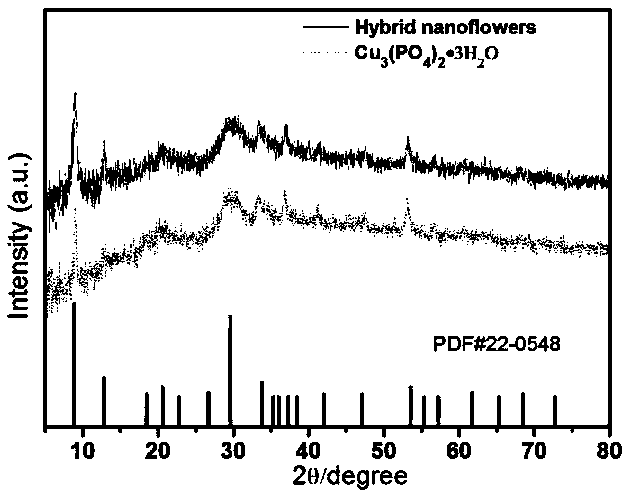An enzyme-linked immunosorbent assay method based on biotinylated antigen or antibody-inorganic salt hybrid nanoflowers
A technology of biotinylated antigen and enzyme-linked immunosorbent adsorption, which is applied in the field of immunological detection, can solve problems such as overnight reaction, and achieve the effect of high sensitivity, high applicability, and wide detection range
- Summary
- Abstract
- Description
- Claims
- Application Information
AI Technical Summary
Problems solved by technology
Method used
Image
Examples
Embodiment 1
[0040] [Example 1] The biotinylated antibody-inorganic salt hybrid nanoflower of the present invention is used for rapid and efficient detection of the cancer marker alpha-fetoprotein (AFP) test (3D ELISA)
[0041] 1) Add 4 μL copper sulfate solution to 600 μL phosphate buffer solution containing biotinylated alpha-fetoprotein (AFP) monoclonal antibody, and place at room temperature for 18 hours to obtain biotinylated antibody-inorganic salt hybrid nanoflowers;
[0042] The concentration of the phosphate buffer solution is 0.1M, pH 7.4; the concentration of the copper sulfate solution is 120mM; the concentration of the antibody is a biotinylated alpha-fetoprotein monoclonal antibody is 0.016mg / mL.
[0043] 2) The above mixture was centrifuged to obtain a precipitate, washed three times with deionized water to obtain the washed biotinylated antibody-inorganic salt hybrid nanoflower complex; the centrifugation speed was 10000r / min, and the centrifugation time was 10min.
[0044]...
Embodiment 2
[0053] [Example 2] Traditional 2D ELISA is used to detect the cancer marker alpha-fetoprotein (AFP) test
[0054] 1) Add 50 μL alpha-fetoprotein (AFP) monoclonal antibody (20 μg / mL) to the well of a Thermo Fisher Scientific Inc. (Cat. No.: 446469) microtiter plate and incubate overnight at 4°C.
[0055] 2) Pour off the solution in the coated microtiter plate, add 300 μL of BSA solution (2%), and block at 37° C. for 2 hours.
[0056] 3) Add different concentrations of AFP standard solutions to the antibody-coated ELISA plate, shake gently to mix, cover or cover the ELISA plate, and react at 37°C for 45 minutes.
[0057] 4) Discard the liquid, wash five times, and pat dry. Add 50 μL of HRP-labeled anti-AFP antibody at a concentration of 20 μg / μL to each well, and react at 37° C. for 45 minutes.
[0058] 5) After incubation, discard the liquid in the wells, wash the plate 5 times, and pat dry. Add 50 μL of TMB chromogenic working solution to each well, and develop color at 37°...
Embodiment 3
[0063] [Example 3] Coating time optimization of the biotinylated antibody-inorganic salt hybrid nanoflower synthesized in Example 1
[0064] 1) The biotinylated antibody-inorganic salt hybrid nanoflowers obtained in Example 1 were uniformly dispersed in PBST buffer solution, placed in a streptavidin-modified well plate, and incubated at 37°C for 5, 10, After 30, 60, 90, and 120 min, wash five times with washing solution, then add 300 μL of 2% BSA solution, and block at 37°C for 45 min to obtain an ELISA plate coated with biotinylated antibody-inorganic salt hybrid nanoflowers ( "3D Substrate" for short), and stored at 4°C for future use. The washing solution is PBST (10 mM, 150 mM NaCl, 0.05% Tween 20, pH 7.2).
[0065] 2) Add 50 microliters of 25ng / mL AFP standard solution to the microtiter plate coated with biotinylated antibody-inorganic salt hybrid nanoflowers, shake gently to mix, cover or cover the microtiter plate, and keep at 37°C React for 45 minutes.
[0066] 3) D...
PUM
| Property | Measurement | Unit |
|---|---|---|
| concentration | aaaaa | aaaaa |
| adsorption capacity | aaaaa | aaaaa |
Abstract
Description
Claims
Application Information
 Login to View More
Login to View More - R&D
- Intellectual Property
- Life Sciences
- Materials
- Tech Scout
- Unparalleled Data Quality
- Higher Quality Content
- 60% Fewer Hallucinations
Browse by: Latest US Patents, China's latest patents, Technical Efficacy Thesaurus, Application Domain, Technology Topic, Popular Technical Reports.
© 2025 PatSnap. All rights reserved.Legal|Privacy policy|Modern Slavery Act Transparency Statement|Sitemap|About US| Contact US: help@patsnap.com



